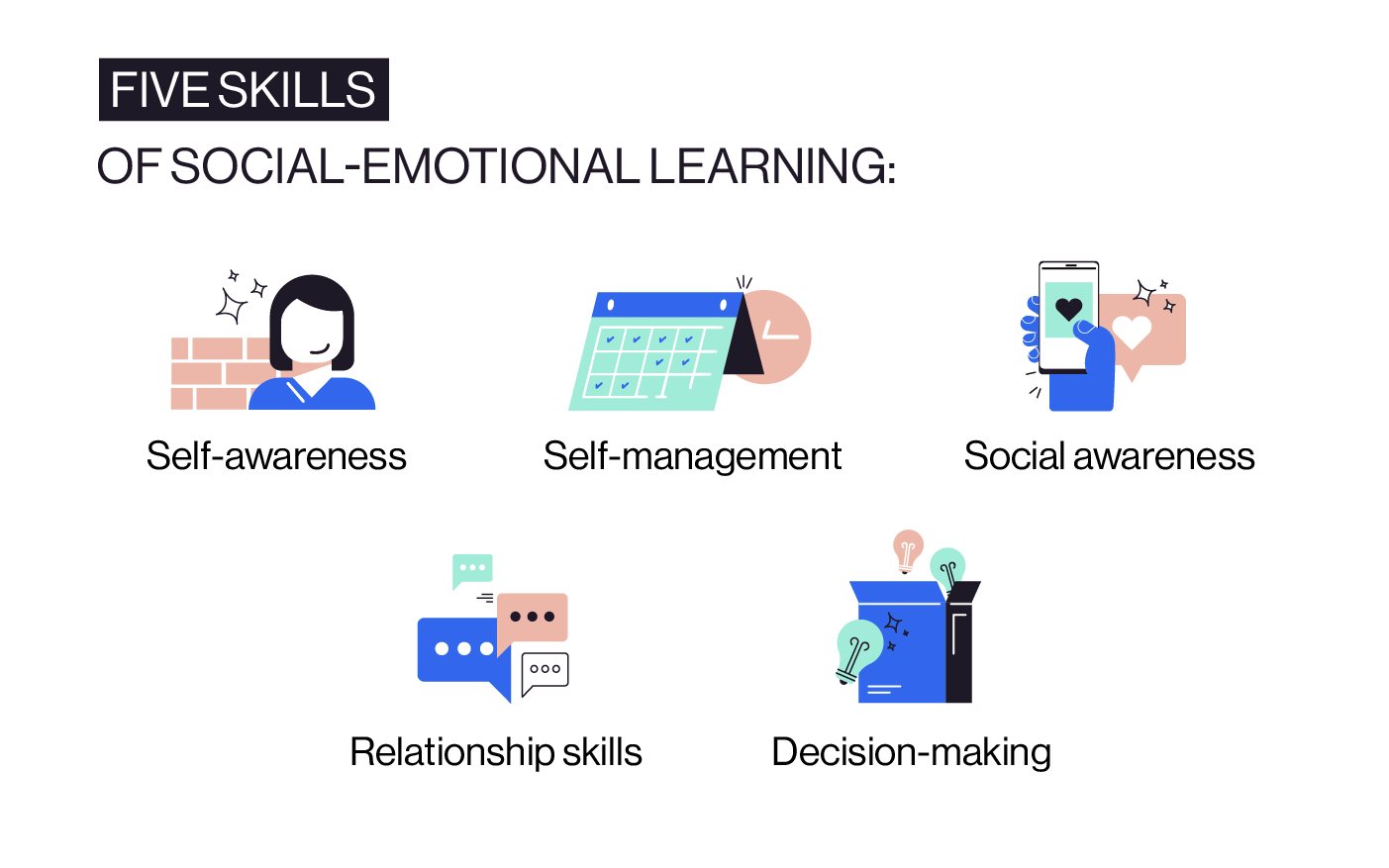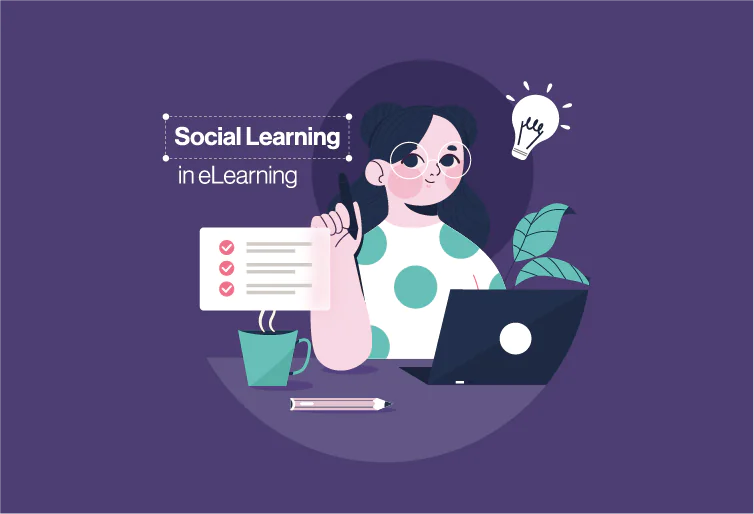What Social Learning Approach Is?
Social and emotional learning (or, in short, SEL) is one of the main parts of human understanding and through which we acquire and apply knowledge and develop a healthy identity. The main objective of Social and emotional learning is to create a learning environment based on trusting and collaborative relationships, rigorous and meaningful curricula and instructions, and ongoing assessment.
The social learning approach increases students’ social and emotional skills by 83%, due to which 93% of teachers believe that this teaching format is just as important as academic learning.
Any SEL training involves the following five skills:
- Self-awareness. Skill responsible for the correct awareness of their own emotions, personal goals, and values.
- Self-management. This skill is responsible for the correct regulation of the student’s own emotions and behavior.
- Social awareness. This skill is responsible for understanding and empathy for the culture and background of other students.
- Relationship skills. This skill speaks for itself and is responsible for the ability to establish relationships with other students.
- Decision-making. Responsible for making the right decisions based on their behavior in society.
All these skills help students in learning and in all areas of life that are used constantly. Thus, they are critical to both successful studies and a successful career after graduation.
Benefits of Social Learning Approach
It is unlikely that the educators would be so positively disposed towards social and emotional learning and would hardly have implemented it actively if this training format did not benefit. Therefore, we have collected the most important perks that apply to the educational process in general and each student in particular.
1. Learning Performance Improvement
Once you start developing students ‘social and emotional skills, you will immediately notice how students’ overall academic performance will increase. According to the surveys, social and emotional learning increases student performance by 11%, an excellent indicator. The soft skills, the development of which is included in SEL, improve the general attitude of students towards learning and at the same time enhance academic performance. The students understand that their opinions will be heard and accepted in the circle of other students, which helps to focus on the learning process itself.
2. Decreasing Behaviour Problems
The social learning approach positively affects the overall behavior of students, making them less aggressive. In addition, numerous social studies have shown that students involved in social and emotional learning experience 10% fewer psychological and behavioral problems that can negatively affect the student.
3. Decreasing Stress
Stress is one of the reasons why students have a negative attitude towards learning, problems in relationships begin, and overall academic performance can sink. However, according to research scientists, social and emotional learning affects central executive cognitive functions, which improves inhibitory control, planning, and the ability of students to switch attention from one task to another. This has a positive effect on students’ self-regulation skills.
4. Enhancing Social Behaviour
Studying is always a joy when it turns out to find a common language with other students and teachers. Social skills are the foundation for building productive relationships with peers and educators. A closer and more trusting student-teacher relationship encourages students to do better and brings positive long-term benefits. For example, when teachers inspire their students to take challenges beyond the classroom, such as going to college or participating in student competitions, it will provide a good background for the future.
How to Implement a Social Learning Approach in Your Learning Process?
So, we figured out the main benefits you will receive by implementing SEL into your training program. It’s time to talk about how to add social and emotional learning to your classroom or curriculum. You can use all these methods separately or all together. It’s up to you and your learning needs.
1. Implement Daily Morning Meetings or Check-Ins
Each student in your group is unique and comes to class with their own unique experiences and emotions. The social learning approach includes morning meetings, which last a maximum of 15-20 minutes, allow students to share their feelings with classmates and teachers, establish a connection and develop empathy for each other.
2. Add Peer Mediation Into Problem-solving
In a classroom of any size, there will always be situations or problems that need to be addressed, whether it’s a conflict between two students or a dispute about the lesson’s topic. And such conditions are ideal when the whole class or a small group of students can solve a problem while not forgetting to understand. Ask both sides for their views on a particular issue and try to find common ground. Spurring such modeling over time will undoubtedly bear fruit since the students will adopt this method and use it in class life and everyday life.
4. Involve Role-Playing Activities Into Lessons
Empathy is a challenging skill to master and requires a different approach. Role-playing is another part of the social learning approach to help students understand a new perspective and start moving towards more empathy for the rest of the students. For example, you can gather students into groups and give them the task to act out certain emotions (after providing each student a specific card with a feeling). Meanwhile, the rest of the students must guess what emotion is being portrayed in front of them. Further, as part of an interactive lesson, you can discuss ways to deal with these emotions that should be used to improve their well-being.
5. Use Anchor Charts
Anchor charts are an excellent tool for integrating social and emotional learning into your class as they allow you to take notes in real-time so students can look back in case they need a reminder. Such diagrams can be applied to various social skills, positive affirmations, the three A’s to be an active listener, the definition of peer mediation, and so on. Important information about social skills will always be in front of students, thereby being deposited in their memory.
6. Finish the Study Session Correctly
With the social learning approach, each study session or day should end with a small talk about how the students felt during the day, mainly what went well and what went wrong. In addition, together with the students, it is worth formulating goals for the next lesson or day, giving a clear idea of what awaits them in the future.
Wrapping Up
As you can see for yourself, the social learning approach is a handy tool for improving the overall student experience that aims to develop social skills that will be useful in further training and after its completion. Do not forget that involving students in such activity changes their attitude towards learning, making the study itself more enjoyable and productive. And if you need help integrating a social learning approach into your online course or classes, Raccoon Gang has strategies on how to get it right.
Raccoon Gang has many years of experience developing custom online learning solutions, courses, and online learning audits for various industries. All you have to do is drop us a line, and our manager will contact you to discuss your project in detail.
- What Social Learning Approach Is?Social and emotional learning (or, in short, SEL) is one of the main parts of human understanding and through which we acquire and apply knowledge and develop a healthy identity. The main objective of Social and emotional learning is to create a learning environment based on trusting and collaborative relationships, rigorous and meaningful curricula and instructions, and ongoing assessment.The social learning approach increases students’ social and emotional skills by 83%, due to which 93% of teachers believe that this teaching format is just as important as academic learning.Any SEL training involves the following five skills: Self-awareness. Skill responsible for the correct awareness of their own emotions, personal goals, and values. Self-management. This skill is responsible for the correct regulation of the student's own emotions and behavior. Social awareness. This skill is responsible for understanding and empathy for the culture and background of other students. Relationship skills. This skill speaks for itself and is responsible for the ability to establish relationships with other students. Decision-making. Responsible for making the right decisions based on their behavior in society. All these skills help students in learning and in all areas of life that are used constantly. Thus, they are critical to both successful studies and a successful career after graduation.Benefits of Social Learning ApproachIt is unlikely that the educators would be so positively disposed towards social and emotional learning and would hardly have implemented it actively if this training format did not benefit. Therefore, we have collected the most important perks that apply to the educational process in general and each student in particular.1. Learning Performance ImprovementOnce you start developing students 'social and emotional skills, you will immediately notice how students' overall academic performance will increase. According to the surveys, social and emotional learning increases student performance by 11%, an excellent indicator. The soft skills, the development of which is included in SEL, improve the general attitude of students towards learning and at the same time enhance academic performance. The students understand that their opinions will be heard and accepted in the circle of other students, which helps to focus on the learning process itself.2. Decreasing Behaviour ProblemsThe social learning approach positively affects the overall behavior of students, making them less aggressive. In addition, numerous social studies have shown that students involved in social and emotional learning experience 10% fewer psychological and behavioral problems that can negatively affect the student.3. Decreasing StressStress is one of the reasons why students have a negative attitude towards learning, problems in relationships begin, and overall academic performance can sink. However, according to research scientists, social and emotional learning affects central executive cognitive functions, which improves inhibitory control, planning, and the ability of students to switch attention from one task to another. This has a positive effect on students' self-regulation skills.4. Enhancing Social BehaviourStudying is always a joy when it turns out to find a common language with other students and teachers. Social skills are the foundation for building productive relationships with peers and educators. A closer and more trusting student-teacher relationship encourages students to do better and brings positive long-term benefits. For example, when teachers inspire their students to take challenges beyond the classroom, such as going to college or participating in student competitions, it will provide a good background for the future.How to Implement a Social Learning Approach in Your Learning Process? So, we figured out the main benefits you will receive by implementing SEL into your training program. It's time to talk about how to add social and emotional learning to your classroom or curriculum. You can use all these methods separately or all together. It’s up to you and your learning needs.1. Implement Daily Morning Meetings or Check-InsEach student in your group is unique and comes to class with their own unique experiences and emotions. The social learning approach includes morning meetings, which last a maximum of 15-20 minutes, allow students to share their feelings with classmates and teachers, establish a connection and develop empathy for each other.2. Add Peer Mediation Into Problem-solvingIn a classroom of any size, there will always be situations or problems that need to be addressed, whether it's a conflict between two students or a dispute about the lesson’s topic. And such conditions are ideal when the whole class or a small group of students can solve a problem while not forgetting to understand. Ask both sides for their views on a particular issue and try to find common ground. Spurring such modeling over time will undoubtedly bear fruit since the students will adopt this method and use it in class life and everyday life.4. Involve Role-Playing Activities Into LessonsEmpathy is a challenging skill to master and requires a different approach. Role-playing is another part of the social learning approach to help students understand a new perspective and start moving towards more empathy for the rest of the students. For example, you can gather students into groups and give them the task to act out certain emotions (after providing each student a specific card with a feeling). Meanwhile, the rest of the students must guess what emotion is being portrayed in front of them. Further, as part of an interactive lesson, you can discuss ways to deal with these emotions that should be used to improve their well-being.5. Use Anchor ChartsAnchor charts are an excellent tool for integrating social and emotional learning into your class as they allow you to take notes in real-time so students can look back in case they need a reminder. Such diagrams can be applied to various social skills, positive affirmations, the three A’s to be an active listener, the definition of peer mediation, and so on. Important information about social skills will always be in front of students, thereby being deposited in their memory.6. Finish the Study Session CorrectlyWith the social learning approach, each study session or day should end with a small talk about how the students felt during the day, mainly what went well and what went wrong. In addition, together with the students, it is worth formulating goals for the next lesson or day, giving a clear idea of what awaits them in the future.Wrapping UpAs you can see for yourself, the social learning approach is a handy tool for improving the overall student experience that aims to develop social skills that will be useful in further training and after its completion. Do not forget that involving students in such activity changes their attitude towards learning, making the study itself more enjoyable and productive. And if you need help integrating a social learning approach into your online course or classes, Raccoon Gang has strategies on how to get it right.Raccoon Gang has many years of experience developing custom online learning solutions, courses, and online learning audits for various industries. All you have to do is drop us a line, and our manager will contact you to discuss your project in detail.
- Benefits of Social Learning Approach
- How to Implement a Social Learning Approach in Your Learning Process?
- Wrapping Up




